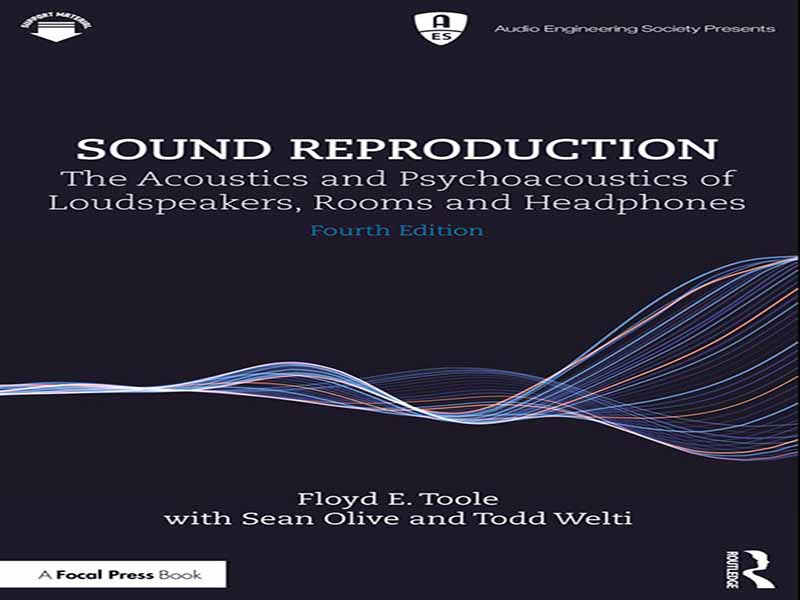- عنوان کتاب: Sound Reproduction – The Acoustics and Psychoacoustics of Loudspeakers, Rooms and Headphones 4th Edition
- نویسنده: Floyd E. Toole, Sean Olive, Todd Welti
- حوزه: آکوستیک
- سال انتشار: 2025
- تعداد صفحه: 931
- زبان اصلی: انگلیسی
- نوع فایل: pdf
- حجم فایل: 30.3 مگابایت
صدای بازتولید شده بخش اجتنابناپذیری از زندگی ماست. بخش زیادی از آن در پسزمینه است؛ گاهی اوقات ما گزینشی عمل میکنیم و آن را به پیشزمینه میآوریم. برای سرگرمیهای جدیتر، مینشینیم و از آن یک رویداد میسازیم، گاهی اوقات با همراهی ویدیو. ما به بلندگوها در خانهها و ماشینها، هدفونها و دستگاههای صوتی قابل حمل با اشکال و اندازههای مختلف گوش میدهیم. اگر بیطرفانه نگاه کنیم، صدایی که میشنویم طیف گستردهای از کیفیتهای صدا را در بر میگیرد. عناصر اساسی برنامهها از انواع مختلف توهینهای شنیداری جان سالم به در میبرند، اما وقتی کسی چیزی بهتر میشنود، درک این نکته که پیام چیزی بیش از آنچه شنیده شده است، دشوار نیست. اکثر مردم علاقه یا بودجه کافی برای ارتقاء دستگاههای پخش صوتی خود ندارند و با شرایط نامطلوب سازگار میشوند. زندگی ادامه دارد. اما فرض کنید کسی از صدای خوب قدردانی میکند و بهترین کیفیت صدا، صداگذاری و تصویربرداری را در موسیقی استریو و پوشش جذاب و تنوع جهتداری را که صدای چند کاناله میتواند به ارمغان بیاورد، میخواهد. فرض کنید کسی میخواهد حس غوطهوری، احاطه شدن توسط مخاطب در یک کنسرت یا جلوههای ویژه هیجانانگیز مبتنی بر طرح داستان در فیلمها را تجربه کند. با داشتن پول کافی، میدانیم که این اهداف قابل دستیابی هستند، اما برای بسیاری، این یک عامل بازدارنده بوده است. خوشبختانه، به دلیل فناوری امروزی، مهندسان ماهر و راهنماییهای علمی، نقطه بازده نزولی به طرز چشمگیری در قیمت کاهش یافته است. دانش، کیفیت صدای خوب را با قیمتهای مقرون به صرفه در دسترس قرار داده است. بلندگوهای سطح مبتدی ممکن است شیک نباشند، بیس عمیقی نداشته باشند یا نتوانند در سطح صدای سینما پخش کنند، اما وقتی به خوبی طراحی شوند، صدایی اساساً بیرنگ و خنثی ارائه میدهند. یک ساب ووفر اضافه کنید و میتوانید شگفتیهای دلپذیری داشته باشید. هدفونهای ارزان قیمت خوب انتخاب شده میتوانند با بسیاری از مدلهای گران قیمت از نظر کیفیت و کمیت صدا رقابت کنند. این یکی از رضایتبخشترین پاداشهای علم کاربردی مورد بحث در این کتاب است. وقتی تحقیقات، دانشی از رابطه بین آنچه میشنویم و آنچه اندازهگیری میکنیم، به دست میدهد، میتوان اهداف طراحی قابل اندازهگیری را برای مهندسان تعیین کرد تا محصولاتی طراحی کنند که احتمال رضایت شنوندگان را بالا ببرند. استفاده از اصطلاح «رضایتبخش» نشان میدهد که رضایت شنوندگان لزوماً به اندازه شنوندگان باتجربه یا حرفهای مهم نیست. جالب توجه است که حدود ۶۰ سال آزمایشهای شنیداری دوسوکور و با بلندی صدای برابر با استفاده از شنوندگانی از هر پیشینهای نشان داده است که اکثر شنوندگان با شنوایی نسبتاً طبیعی در مورد آنچه «خوب» به نظر میرسد، اتفاق نظر دارند و آنچه «خوب» به نظر میرسد، کمرنگترین و خنثیترین صدا بوده است. بلندگوهایی که از نظر ذهنی رتبهبندی بالایی دارند، از نظر فنی دقیقترین هستند و کمترین شواهد رزونانس، یکنواختترین پاسخهای فرکانسی با وسیعترین پهنای باند را نشان میدهند. همبستگی بین آنچه شنیده میشود و آنچه اندازهگیری میشود، به طرز چشمگیری بالا است و روابط منطقی هستند. همه اینها دلگرمکننده است، اما داشتن بلندگوهای «عالی» صدای «عالی» را تضمین نمیکند. اتاقهای شنیداری دارای رزونانسهایی هستند که باعث غرشهای باس و رنگآمیزی میشوند. باس در صندلیهای مختلف متفاوت است. باس حدود ۳۰٪ از عوامل مؤثر در قضاوتهای کیفیت صدا را تشکیل میدهد. نمیتوان آن را نادیده گرفت. مشکلات برای هر اتاق متفاوت است و تنها راه حل، رسیدگی به آن در اتاق پس از راهاندازی سیستم است. تاد ولتی، نویسنده همکار من، توضیح خواهد داد که چگونه.
Reproduced sound is an inescapable part of our lives. Much of it is in the background; occasionally we get selective and bring it into the foreground. For more serious entertainment we sit down and make an event of it, sometimes with video accompaniment. We listen to loudspeakers in homes and cars, headphones, and portable audio devices of many shapes and sizes. Viewed objectively, the sound we hear embraces a wide range of sound qualities. The basic elements of the programs survive many kinds of auditory insults, but, when one hears something better, it is not difficult to appreciate that there is more to the message than was being heard. Most people lack the interest or budget to upgrade their audio delivery devices, and they adapt to compromised circumstances. Life goes on. But suppose that one appreciates good sound, and wants the best in sound quality, soundstage and imaging in stereo music, and the engaging envelopment and directional diversity that multichannel audio can bring. Suppose one wants to experience the sense of immersion, of being surrounded by an audience at a concert, or the exciting plot-driven special effects in movies. With enough money we know these are achievable goals, but for many that has been a deterrent. Fortunately, because of today’s technology, skilled engineers and scientific guidance the point of diminishing returns has fallen dramatically in price. Knowledge has made good sound quality available at affordable prices. The entry-level loudspeakers may not be stylish, have deep bass or be able to play at cinema sound levels, but when well designed, they deliver fundamentally uncolored, neutral sound. Add a subwoofer and there can be pleasant surprises. Well-chosen inexpensive headphones can compete with many expensive models in both quality and quantity of sound. This is one of the most satisfying rewards of the applied science discussed in this book. When research yields knowledge of the relationship between what we hear and what we measure, it is possible to set measurable design objectives for engineers to design products that have a high probability of pleasing listeners. Using the term “pleasing” suggests that the listeners being satisfied are not necessarily as critical as experienced or professional listeners. Interestingly, about 60 years of double-blind, equalloudness listening tests using listeners of all backgrounds have shown that most listeners with relatively normal hearing agree on what sounds “good”, and what sounds “good” has turned out to be the least colored, most neutral sound. Loudspeakers that are subjectively highly rated turn out to be the most technically accurate, exhibiting the least evidence of resonances, the most uniform frequency responses with the widest bandwidth. The correlation between what is heard and what is measured is impressively high, and the relationships make sense. This is all encouraging, but having “perfect” loudspeakers does not guarantee “perfect” sound. Listening rooms have resonances that cause bass booms and coloration. The bass is different in different seats. Bass accounts for about 30% of the factors contributing to sound quality judgments. It cannot be ignored. The problems are different for every room, and the only solution is to address it in the room after the system is set up. My co-author Todd Welti will explain how.
این کتاب را میتوانید از لینک زیر بصورت رایگان دانلود کنید:
Download: Sound Reproduction




































نظرات کاربران